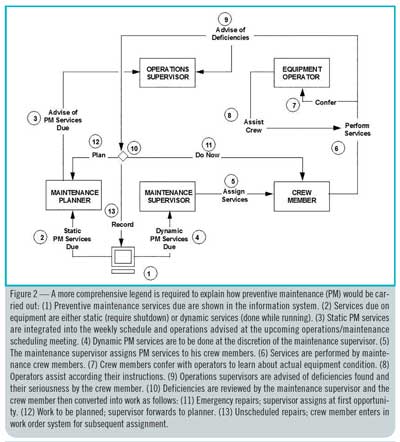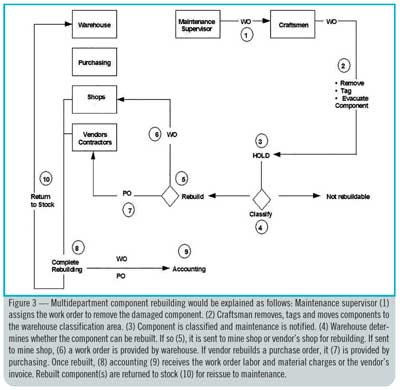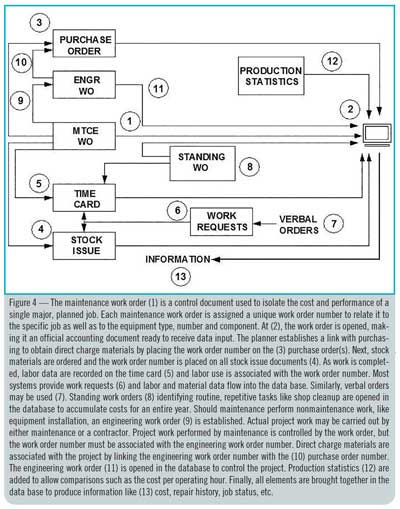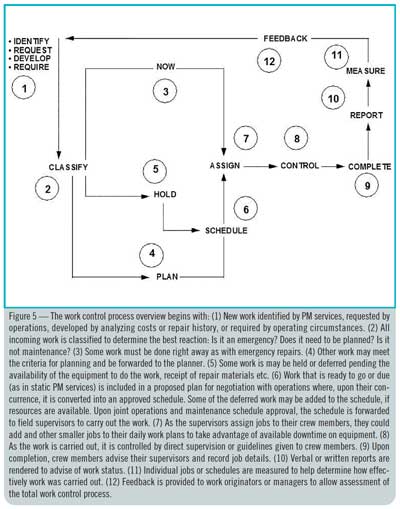The third step in the path toward achieving world-class maintenance is to establish an effective mine maintenance program. This consists of developing, documenting, testing, and implementing a quality program that spells out how maintenance work is requested, identified, classified, planned, scheduled, assigned, controlled, measured and assessed to ensure sustained, effective performance. After a program is developed and agreed upon, an educational effort is carried out to ensure that the entire mining operation understands what maintenance does, who does what, how and why. Personnel will then see their supporting and cooperative maintenance-related roles clearly and contribute more effectively to the success of the total operation.
Note that the program is the mine maintenance program — not the program of the maintenance department. Why? Maintenance planning, for example, is a maintenance function and maintenance bears full responsibility for its success. However, planning will not be successful without the support of warehousing and purchasing to supply materials or cooperation from operations in making equipment available for work. These other departments have a definitive role in planning success and become an integral part of the mine maintenance program.
WHAT IT IS
What is the mine maintenance program? In short, it describes what is to be done, by whom, how and why. It reflects the interaction of the total mine population as work is requested or identified and classified to determine the best outcome. The program includes planning, scheduling, assignment, control and measurement of the resulting work. Finally, it enables assessment of overall accomplishment against goals such as performance standards and budgets.
Mining organizations often fail to adequately define their maintenance programs. As a result, maintenance personnel who are tasked to carry them out become confused and uncertain. Operations staff wonder how they can best support maintenance. Departments such as warehousing try to second guess what maintenance needs. Mine managers are frustrated and impatient. In instances where maintenance programs have not been defined, operating departments — as well as staff departments whose help is essential to successful maintenance — have little idea of what is expected of them. Thus, essential, basic support for the program is not provided. Instead, confusion and uncertainty prevail.
To avoid this situation, invite other departments to review and comment on actions that involve them after maintenance has documented a preliminary program. Operations, for example, may have only a vague idea of how the preventive maintenance (PM) program actually works or what the planner is supposed to do. An explanation, along with a review of the program’s preliminary schematic diagram, will help to eliminate any misunderstanding. But more importantly, operations personnel will recognize the actions that they must take in order for the maintenance program to serve them effectively. They will also become aware that the objectives and policies of the production strategy are incorporated into the program. Staff personnel, especially from warehousing and purchasing, will now realize the importance of attending and participating in the weekly operations and maintenance scheduling meetings. Accounting will better appreciate the critical maintenance need for quality information.
The process of defining the program yields better understanding of program procedures, gains commitment, and educates personnel on program execution, support and cooperation. The essential interaction of mine departments is confirmed as mutual activities are carried out. Warehousing and purchasing, for example, will specify procedures to obtain materials while maintenance will include these procedures in their own programs to ensure they are understood and followed.
 GETTING STARTED
GETTING STARTED
The program definition begins with the mine manager who will provide guidance enabling development of a solid production strategy that meshes with mining operation needs and meets corporate requirements. Departmental objectives and policies will be assigned so that departments can develop the interlocking procedures that make the mine’s maintenance program work efficiently.
Define the program and educate the workforce — Program definition is a composite action of all departments. As they work together, maintenance crews, equipment operators, supervisors and staff personnel such as planners, warehouse personnel or purchasing agents should confer as the procedures for each department are being developed. This collaboration assures the practicality and workability of the final program.
Key maintenance personnel should be involved in the initial development of the program. Each element of the program should be discussed to determine how activities will be depicted. How will preventive maintenance services be scheduled or what criteria will determine which jobs are planned, for example?
Education must include everyone in the mine from worker to manager. Mine managers should make a special effort to observe the discussion between departments as they commit to procedures necessary to carry out the production strategy. Questions should be answered promptly and correctly. Recommendations should be welcomed and encouraged.
Program definition techniques — The most effective technique for documenting the program is a schematic diagram accompanied by a legend to facilitate explanation and understanding. While tools such as flow charts, decision trees or narratives with diagrams might be used, none are as effective as the schematic diagram in showing the interaction of people. Mine personnel and their actions are pinpointed to help bind people to the program.
First, identify the key personnel and lay out a rough diagram. If these personnel were to include, for example, a maintenance supervisor, his crew, an operations supervisor and operators, position them logically. As the preliminary diagram starts to take shape, individuals are linked with various actions using arrows pointing to the person receiving information and simple captions like “assign” or “inspect.” The sequences of events are numbered in the order they take place and preliminary explanations are placed in the legend (Figure 1).
The narrative in the legend should be brief and simple. During the explanation of the program, personnel will let you know whether the explanation needs to be expanded or clarified. Continue to diagram, focusing on each element of the program and the interactions necessary to carry it out. Consider preventive maintenance (Figure 2).
Elements of the mine maintenance program are best developed individually then linked together. Diagram PM and compose the legend, then diagram and compose the legend for planning.
 As the process continues, compare diagrams and legends to ensure they are consistent and logical. Thus, if static PM services are to be included in the weekly schedule, they must be cross-referenced in the planning diagram showing them being added to the weekly schedule.
As the process continues, compare diagrams and legends to ensure they are consistent and logical. Thus, if static PM services are to be included in the weekly schedule, they must be cross-referenced in the planning diagram showing them being added to the weekly schedule.
Keep in mind that multiple departments are involved in many maintenance activities. Planning, for example, requires interaction with the warehouse, purchasing and shops. By diagramming these interrelationships, involved departments will have the opportunity to discuss the procedures and their validity. Consider the task of component rebuilding (Figure 3).
Within maintenance, it is important to include new supervisors and those transferred from other organizations. They will welcome the clarification that the program brings. Personnel from other departments will be made aware of what maintenance does, how they do it, who does what and why.
Collaborative working relationships will evolve to ensure better understanding and improved cooperation. Maintenance is not a “stand-alone” activity; it requires the help of many other departments. Remember that if one needs help, the first step is to tell those who can help exactly how they can help. It follows that if they are not told, they will either guess at what is needed and deliver the wrong support or worse yet, do nothing.
An integrated information system is the communications network for the total mine. Maintenance is one user along with warehousing, purchasing and operations. Information is used for internal actions and shared between departments and with management. Thus, system use appears in many parts of program documentation: scheduling PM, reporting labor use or ordering parts. The accounting system is the counterpart to the information system in converting field data like labor use into costs and job status. It is important that the program depict an accurate picture of its use: especially how the work order and accounting systems work together (Figure 4).
Before assembling the separate elements of the program such as PM or planning, sketch a diagram of the expected work control elements that will be included in the program. This will serve as a checklist of how the program elements will fit together and how key personnel must interact (Figure 5).
Assemble program elements — Assemble the elements that will make up the maintenance program by examining the current organizational chart. This step is taken to ensure that all necessary maintenance personnel are accounted for and included in the preliminary program. Once program details are agreed upon, the current organization can be confirmed or altered to fit the circumstances of the program.
 EXPECT SOME CHANGES
EXPECT SOME CHANGES
Keep in mind that the new program may signal changes required in the organization or the duties of key personnel. To illustrate: In an existing maintenance practice, planners devised a weekly schedule to present to operations. This practice had netted an unsatisfactory schedule compliance of only 33%.
Upon discussing the new program with operations, they required maintenance to present a plan of required work, already planned and ready. Both parties then negotiated the schedule times to interfere least with operations and make the best use of maintenance resources. Within six weeks schedule compliance doubled and the new procedure was incorporated along with revised planner duties.
Include craftsmen in program discussions as they are the ones who must carry out the actual work, and will have a practical view of what should be done and how. Their participation allows realistic input and a sense of ownership of the program as opposed to wondering about the mysterious process being concocted behind closed doors and soon to be inflicted on them.
Finally, when the maintenance and operations managers meet with the mine manager and jointly announce, “this is our maintenance program,” the mine manager will have confirmed that his production strategy is going to be carried out effectively.
In summary, keep in mind that the most important aspect of program development is the participation of personnel in the process. Personnel from all departments become familiar with the activities of other departments. They will see how their own actions impact interdepartmental cooperation. Participation encourages input of ideas and generates a sense of ownership in the new program. In turn, this ownership suggests a commitment to make the program work.
Next month: Step 4 — How to select the best information system to control the maintenance program and how to use it effectively.
 ABOUT THE AUTHOR
ABOUT THE AUTHOR
Paul D. Tomlingson (pdtmtc@msn.com) is a Denver-based maintenance management consultant. His latest book, Maintenance in Transition — The Journey to World-class Maintenance, includes a detailed two-page diagram of an actual program accompanied by a coordinated step-by-step legend. Copies of the book (ISBN 978-1-4675-9069-3, 395 pp.) can be purchased from the author. He welcomes inquiries concerning these articles.

